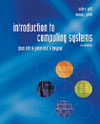
|  |
Whats New| Chapter 1: Discussions have been added on the nature and importance of abstraction and the interplay of hardware and software. Chapter 3: A new section has been added on finite state control and its implementation as a sequential switching circuit to underline the importance of this topic. Chapter 4: This chapter now contains a section giving a preview of the underlying microarchitecture of the LC-3, which is spelled out in detail in the extensively revised Appendix C. Chapter 5: This chapter has been completely overhauled to accommodate two major improvements. First, the LC-2 has been replaced by the LC-3. Three more years of experience teaching this course has convinced the authors that the ISA studied in this book could be improved in several ways. The LC-3 is the result. Second, the explanations of each of the topics have been expanded to include more figures and more extensive explanations. Chapters 8 & 10: These chapters now include major new sections on interrupt-driven I/O. Chapters 11-14: These chapters are now more focused on the essential aspects of the language useful to a beginning programmer with more examples. [Specialized features like the C switch construct are now at the ends of chapters or in Appendix D.] There is a heavier emphasis on ¿how to program¿ via problem solving examples that demonstrate how newly introduced C constructs can be used in C programming. Recursion: The chapter on recursion (now Chapter 17) has been moved after the chapter on pointers and arrays in order to allow the students to gain more experience with basic programming concepts before making the leap to programming recursive functions. |
|
|